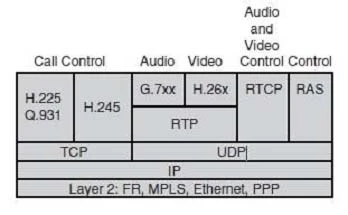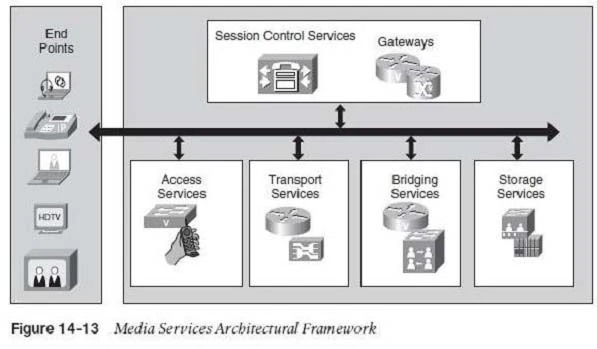Question 6 of 666
Cisco Identity-Based Networking Services relies heavily on the 802.1X protocol. Which other authentication solution is used hand-in-hand with 802.1X to authenticate users for network access?
Correct Answer: A
Question 7 of 666
Which protocol is used for voice bearer traffic?
Correct Answer: B
VoIP Control and Transport Protocols
A number of different protocols are used in a VoIP environment for call control, device provisioning, and addressing.
Figure 14-15 shows those protocols focused on VoIP control and transport.
 B
B
A number of different protocols are used in a VoIP environment for call control, device provisioning, and addressing.
Figure 14-15 shows those protocols focused on VoIP control and transport.
 B
BQuestion 8 of 666
Which protocol is used to reserve bandwidth for the transport of a particular application data flow across the network?
Correct Answer: C
Question 9 of 666
Which two features are supported by single wireless controller deployments? (Choose two.)
Correct Answer: A, B
Question 10 of 666
Which four services does the architecture for Media Services contain? (Choose four.)
Correct Answer: A, B, C, E
An architecture framework for media services supports different models of video models. As shown in Figure 14-13, the network provides service to video media in the Media Services Framework. Those services are access services, transport services, bridging services, storage servers, and session control services, which arc provided to endpoints.
✑ Access services provide identity of end devices, mobility, and location services.
✑ Transport services provide QoS for reliable packet delivery.
✑ Bridging services provide transcoding, conferencing, and recording services of media streams.
✑ Storage services provide capture and storage of media streams and content management and distribution.
Session control services provide session signaling and control and gateway services.

 ABCE
ABCE
✑ Access services provide identity of end devices, mobility, and location services.
✑ Transport services provide QoS for reliable packet delivery.
✑ Bridging services provide transcoding, conferencing, and recording services of media streams.
✑ Storage services provide capture and storage of media streams and content management and distribution.
Session control services provide session signaling and control and gateway services.
 ABCE
ABCE